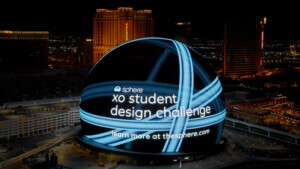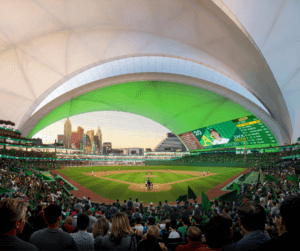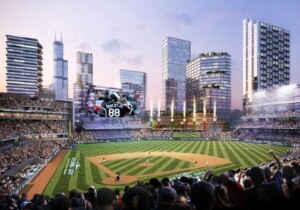Three years ago, the Howard Hughes Corporation (HHC) bought Las Vegas’s Triple A baseball team, the 51s, with the plan of relocating the team from its outdated facility north of downtown Las Vegas to a new state-of-the-art facility in Summerlin, the company’s massive master-planned community of more than 100,000 people at the western edge of the Las Vegas Valley.
Last week HHC unveiled the preliminary design of Las Vegas Ballpark, its new 10,000-capacity ballpark, designed by the San Francisco office of HOK. It is the latest sign that sports are becoming increasingly important both to Las Vegas’ ambition of becoming a “real city” as well as a driver of a new generation of more urban development. This season also marks the debut of Las Vegas’ NHL franchise, the Golden Knights, playing out of a new arena on the Las Vegas Strip (itself part of a large pedestrian-oriented plaza space on the Strip). The NFL’s Oakland Raiders, meanwhile, will relocate to Sin City in a brand new stadium starting in 2020.
The new baseball park will form the centerpiece of a 400-acre tract called “Downtown Summerlin.” The ballpark will join an existing 1,000-room hotel casino, a large outdoor shopping center that opened in 2014, and a practice rink for the Golden Knights which opened last month. Over the next 10 to 15 years, Hughes expects to fill in the rest of the site with new office buildings, small parks and up to 4,000 urban dwelling units — none of which will be single-family detached homes.
The design, which is still being finalized, will leverage the park’s connection to the desert – the ballpark is a short drive from the color-drenched mountains of the Red Rock National Conservation Area.“There’s something about a project in the desert that’s a little bit different than a project in other places,” said Anton Foss, Managing Principal of HOK’s San Francisco office. The base will be comprised of stucco and earthy burnished blocks. “We’re emphasizing the materiality of the ground — pieces of the project being of the earth,” said Foss.
The other design cue was the legacy of Howard Hughes himself. The aviator and industrialist originally bought up the 25,000-acre parcel that became Summerlin in the 1950s. Development of the land as a master-planned community didn’t begin until the late ’80s. Foss said early plans actually considered trying to incorporate a Hughes museum on site, complete with his legendary Spruce Goose flying boat aircraft.
The idea was abandoned, but it got Foss and his colleagues thinking about Hughes’ aviation legacy. Inspired by aircraft, the upper section is composed of exposed structural steel, glass and metal panels. The roof, Foss promised, “will touch the sky lightly like an aircraft wing.”
A few Vegas touches are planned for the ballpark, including an outfield pool and an outfield concourse lined with games like ping pong tables and corn hole. Las Vegas usually hosts a few Cactus League games during Spring Training, so the new stadium will feature amenities like a clubhouse and a weight room that are designed to impress major league players.
But the watchword here is more about grace than glitz. The design will eliminate complex vertical circulation like ramps — despite an 18-foot west to-east downward slope, the entire park can be accessed by one 360-degree, sloping circulation system.
The ballpark, estimated to cost $150 million, is scheduled to break ground early next year and open for the 2019 season.
As for the 51s’ current home, Cashman Field, plans for next year include hosting a new minor league soccer franchise which will play alongside the baseball team until the 51s move. Beyond that, there are more question marks. The city is kicking around a variety of ideas, ranging from a sports complex (if the minor league soccer team draws interest, it could lead to a Major League Soccer franchise in a few years) to a new campus for tech giant Amazon, which has invited cities to bid for the chance to host their new headquarters.
The Cashman ballpark dates back to 1983 and is one of the oldest Triple A fields in the country. It is part of a larger complex called Cashman Center, which includes a 100,000-square-foot exhibit hall. Just north of downtown Las Vegas, but cut off by an elevated freeway, the Cashman site is adjacent to a popular outdoor neon museum and a public library. The ongoing redevelopment of downtown Las Vegas has yet to cross over the freeway.
For Tom Warden, Senior Vice President with the Howard Hughes Corporation, the future of both Downtown Summerlin and Downtown Las Vegas are bright. For him, the 400-acre Downtown Summerlin site is a dream opportunity to implement New Urbanist policies devoted to walkable, pedestrian-scaled environments on an unprecedented scale. “To be able to build that way tabula rasa is an exciting thing for planners,” he said.










